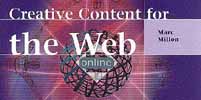|
The
Rhetoric of Hypertext
 Guidelines Guidelines
Editing
and Publishing
Maintenance
How
to order
Other
books by Marc and Kim Millon
|
Every
form of writing is an exercise in rhetoric, of persuading the reader
to trust and believe and be interested in the content on offer. The
style and approach to creating web content naturally depends on the
type of content that is being presented. Certainly the way that substantive,
detailed information is presented persuasively on the web, as in any
other media, is a craft, the approach to which depends on a number of
factors, most particularly, what is the main purpose of the publication
and who is the target audience? The answers to these questions will,
to a great degree, have considerable bearing on how content is constructed,
organized and presented.
Style and Tone
The style and tone of language that one chooses to employ is likely
to be different if the audience is mainly teenagers than if you are
addressing senior citizens. If the function of a web site is mainly
to entertain through the presentation of provocative or avant-garde
content, then the organisation and approach is likely to be different
than the web site that aims to present factual information in a logical
and clear manner. The web site that presents academic content is likely
to be organised differently than the web site that serves to sell or
promote a product. The choice of language in a literary site will almost
by definition be different than that employed in a site that highlights
pop culture. And of course the text that is intended to be read on-line
is likely to organise and present its information in a manner that is
quite different to that of a document that is meant to be accessed,
printed out, then read off-line.
Rhetorical Devices
Writing for the web, moreover, has its own unique rhetorical devices.
The use of hyperlinks, for example, effects the overall visual impression
of a web document, the bits of coloured text adding credibility and
suggesting further avenues of exploration, thus adding depth and authority
to the document. The invitation for the reader to interact with the
content creator or author is another rhetorical device unique to this
medium; it suggests that content is fluid and organic, quite the opposite
in fact, to content set in permanent type or print, and subtly suggests
the potential for intimate interactive dialogue with the author. And
further rhetorical devices such as visual clues, icons, and typographic
effects are utilised to aid in navigation, and allow the author some
degree of control over where the user is likely to visit.
Writing for the web
While content may either be produced especially for publication on the
web, or repurposed from existing text for the web, there are certain
basic rules or suggestions that relate to effective hypertext construction.
Some of the most fundamental findings from web usability studies10 are
that web users do not actually read on the web; rather they tend to
scan material quickly, picking out the most important and relevant points
before moving on elsewhere. Furthermore, users do not like long pages
that require excessive scrolling; preferred text, by contrast, is short,
concise and to the point. And finally, given that there is so much hyped
content on the web, users trust information that is presented calmly
and factually, void of marketese, jargon, or the hyped, ‘hardsell’
presentation of material.
 It is, of
course, important that any decisions relating to approach, style, tone,
organisation, and presentation of a web site are ultimately made depending
on each web site’s overall requirements, function and audience.
Nonetheless, the web has been around sufficiently long for some basic
principles for the construction of effective hypertext to be offered.
That is not to say that every web site author will wish to follow these
guidelines as if they were carved in stone: think of them instead as
set in impermanent electronic digital hypertext, literally here today,
perhaps gone tomorrow, but worth for the moment, at least considering. It is, of
course, important that any decisions relating to approach, style, tone,
organisation, and presentation of a web site are ultimately made depending
on each web site’s overall requirements, function and audience.
Nonetheless, the web has been around sufficiently long for some basic
principles for the construction of effective hypertext to be offered.
That is not to say that every web site author will wish to follow these
guidelines as if they were carved in stone: think of them instead as
set in impermanent electronic digital hypertext, literally here today,
perhaps gone tomorrow, but worth for the moment, at least considering.
Some basic rhetorical guidelines
Editing
and Publishing
Maintenance

|
